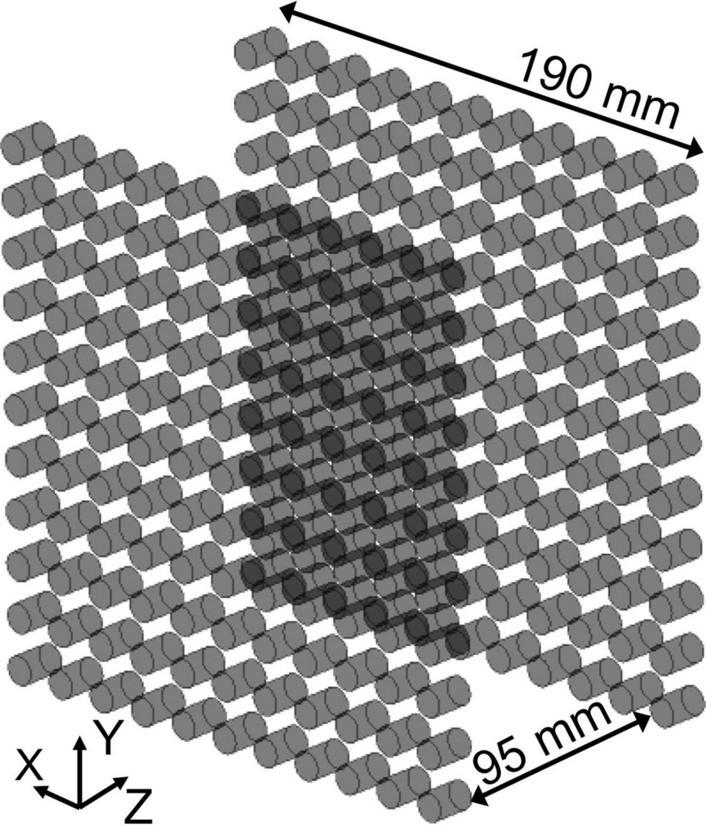Arrayed Design
The tactile display is an important tool to help humans interact with machines through touch. In this paper, we present a multi-array tactile display device with dielectric elastomer actuator (DEA). The device uses the fluid coupling between the contact point and the actuator as power transmission. It is designed to ensure comfort of touch and safety of operation for the users during contact with human skin.
The principle of operation is explained in detail and a systematic design analysis is given. The displacements of the tactile display are about 240-120 m at 3-10 Hz, which meets the frequency requirements for simulating the Merkel cells and Meissner corpuscles, and the force is more than 40 mN to simulate the fingertip. In addition, a special manufacturing method and performance measurements are explained.
The Array Designer app lets you interactively design, visualize, and analyze arrays in the Antenna Toolbox™ library.

With this app you can:
- Show different array configurations and layouts that define element spacing.
- Compare different types of arrays and answers.
- Choose an array configuration to meet specific peak gain, directivity, desired coverage, pattern, gate parameters.
- Change the spacing between the elements and see the effect on the performance of the array.
- Visualize the effect of interconnection in port and in the far field.
- Optimize arrays for different analysis results under certain constraints using SADEA or surrogate optimization methods.
Hyungpil Moon received the B.S. and MS degrees in mechanical engineering from Pohang University of Science and Technology, Pohang, Korea, in 1996 and 1998, respectively, and the Ph.D. degree in mechanical engineering from the University of Michigan, Ann Arbor, in 2005.
In 2008, he joined the faculty of the School of Mechanical Engineering, Sungkyunkwan University, Suwon, Korea, as a full-time lecturer. He was a postdoctoral researcher at the Robotics Institute, Carnegie Mellon University, until November 2007. His current research interests include distributed manipulation, multiple robotic navigation, simultaneous localization and mapping (SLAM), and biomimetic robotics.
Ja Choon Koo (M'00) was born in Seoul, Korea. He received the B.S. degree from Hanyang University, Seoul, Korea, in 1989, and the M.S. and Ph.D. degrees from the University of Texas, Austin, in 1992 and 1997, respectively.
He was the Advisory Engineer of International Business Machines Corporation (IBM), San Jose, CA, and a Staff Engineer of Samsung Information Systems America, San Jose, CA. He is currently an assistant professor at the School of Mechanical Engineering, Sungkyunkwan University, Suwon, Korea. His current research interests include modeling dynamic systems and sensors and actuators.
Jae-Do Nam received the B.S. and MS degrees in chemical engineering from Seoul National University, Seoul, Korea, in 1994 and 1986, respectively, and the Ph.D. degree in chemical engineering from the University of Washington, Seattle, in 1991.
From 1991 to 1993, he was a research associate at the Polymeric Composites Laboratory, University of Washington. In 1993-1994, he was with Jeil Synthetic Fiber Company, Samsung Group. Since 1994, he has been affiliated with Sungkyunkwan University, Suwon, Korea, where he is currently a professor in the Department of Polymer Science and Engineering. His current research interests include polymeric sensors and actuators, organic/inorganic nanocomposites, and biodegradable polymers and composites, and nanoparticles and nanoporous structure. He is the author or co-author of more than 70 technical papers published in journals and conferences.
Hyouk Ryeol Choi (M'95) received the B.S. degree from Seoul National University, Seoul, Korea, in 1984, the M.S. degree from Korea Advanced Institute of Science and Technology (KAIST), Taejon, Korea, in 1986, and the Ph.D. degree from Pohang University of Science and Technology (POSTECH), Pohang, Korea, in 1994, all in mechanical engineering.
From 1986 to 1989, he was an Associate Engineer at LG Electronics Central Research Laboratory, Seoul. From 1993 to 1995, he was a public servant of the Japanese Ministry of Education at Kyoto University, Kyoto, Japan. From 2000 to 2001, he attended the Advanced Institute of Industrial Science Technology (AIST), Tsukuba, Japan, as a Japan Society for the Promotion of Sciences (JSPS) Fellow.
Since 1995, he has been affiliated with Sungkyunkwan University, Suwon, Korea, where he is currently a professor at the School of Mechanical Engineering. He is an Associate Editor of the Journal of Intelligent Service Robotics and International Journal of Control, Automation and Systems. His current research interests include agile mechanisms, field application of robots, and artificial muscle actuators.
